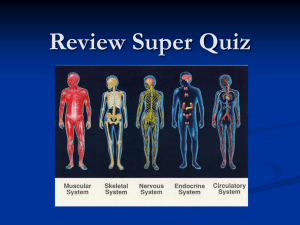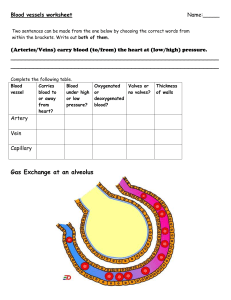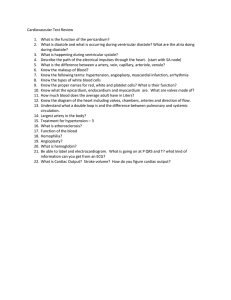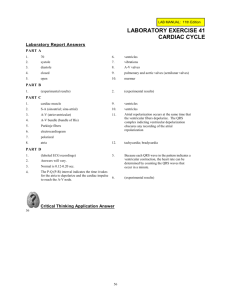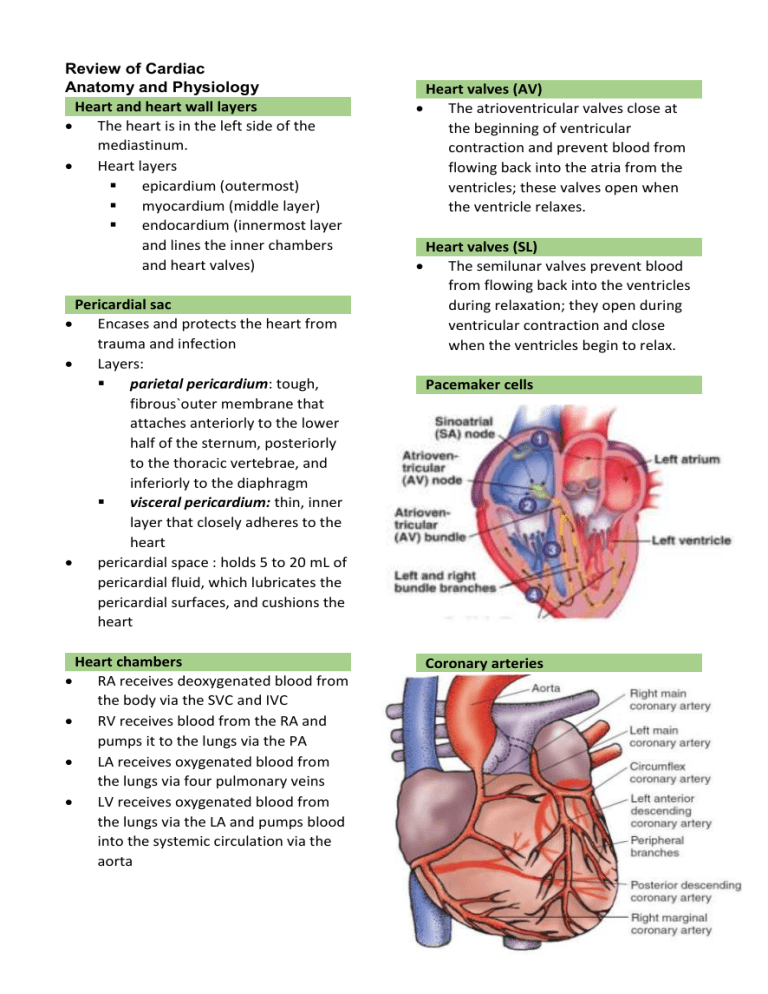
Review of Cardiac Anatomy and Physiology Heart and heart wall layers The heart is in the left side of the mediastinum. Heart layers epicardium (outermost) myocardium (middle layer) endocardium (innermost layer and lines the inner chambers and heart valves) Pericardial sac Encases and protects the heart from trauma and infection Layers: parietal pericardium: tough, fibrous`outer membrane that attaches anteriorly to the lower half of the sternum, posteriorly to the thoracic vertebrae, and inferiorly to the diaphragm visceral pericardium: thin, inner layer that closely adheres to the heart pericardial space : holds 5 to 20 mL of pericardial fluid, which lubricates the pericardial surfaces, and cushions the heart Heart chambers RA receives deoxygenated blood from the body via the SVC and IVC RV receives blood from the RA and pumps it to the lungs via the PA LA receives oxygenated blood from the lungs via four pulmonary veins LV receives oxygenated blood from the lungs via the LA and pumps blood into the systemic circulation via the aorta Heart valves (AV) The atrioventricular valves close at the beginning of ventricular contraction and prevent blood from flowing back into the atria from the ventricles; these valves open when the ventricle relaxes. Heart valves (SL) The semilunar valves prevent blood from flowing back into the ventricles during relaxation; they open during ventricular contraction and close when the ventricles begin to relax. Pacemaker cells Coronary arteries RCA supplies the RA and RV, the inferior portion of the LV, the posterior septal wall, and the SA and AV nodes. The LCA consists of two major branches, the left anterior descending (LADA) and the circumflex arteries. The LADA supplies blood to the anterior wall of the LV, the anterior ventricular septum, and the apex of the LV. The circumflex artery supplies blood to the LA and the lateral and posterior surfaces of the LV. Heart sounds (S1) : heard as the AV close and is heard loudest at the apex (S2) : heard when the SL close and is heard loudest at the base (S3) : heard if ventricular wall compliance is decreased and structures in the ventricular wall vibrate (e.g. CHF or valvular regurgitation) (S4) : heard on atrial systole if resistance to ventricular filling is present Heart rate The faster the heart rate, the less time the heart has for filling, and the cardiac output decreases. An increase in heart rate increases oxygen consumption. Bradycardia Tachycardia Autonomic nervous system (sympathetic) NOREPINEPHRINE: DUE TO HYPOTENSION • Tachycardia • increased conduction rate • increased contractility • peripheral vasoconstriction (parasympathetic) ACETYLCHOLINE: DUE TO HYPERTENSION • Actions opposite to NE BP CONTROL •Baroreceptors •Stretch receptors •Antidiuretic hormone •RAAS ___________________________________ Baroreceptors, also called pressoreceptors, are located in the walls of the aortic arch and carotid sinuses. Increases in arterial pressure stimulate baroreceptors, and the heart rate and arterial pressure decrease. Decreases in arterial pressure reduce stimulation of the baroreceptors and vasoconstriction occurs, as does an increase in heart rate. _________________________________ Stretch receptors, located in the vena cava and the right atrium, respond to pressure changes that affect circulatory blood volume. When the BP decreases as a result of hypovolemia, a sympathetic response occurs, causing an increased heart rate and blood vessel constriction; when the BP increases as a result of hypervolemia, an opposite effect occurs. ________________________________ Antidiuretic hormone (vasopressin) influences BP indirectly by regulating vascular volume. Hypervolemia result in decreased ADH release, increasing diuresis, decreasing BV, and thus decreasing BP. Hypovolemia result in increased ADH release; this promotes an increase in BV and therefore BP. ___________________________________ Renin, a potent vasoconstrictor, causes the BP to increase. Renin converts angiotensinogen to angiotensin I; angiotensin I is then converted to angiotensin II in the lungs ___________________________________ Angiotensin II stimulates the release of aldosterone, which promotes water and sodium retention by the kidneys; this action increases blood volume and BP. Vascular system •Arteries •Arterioles •Capillaries •Venules •Veins


